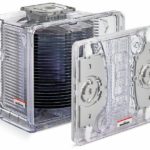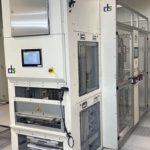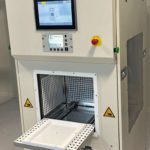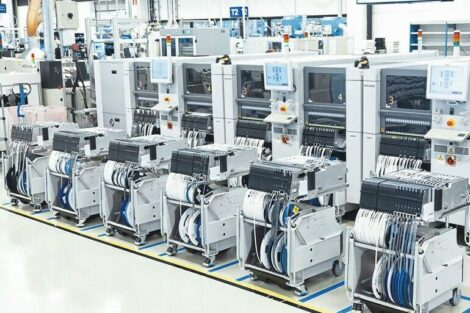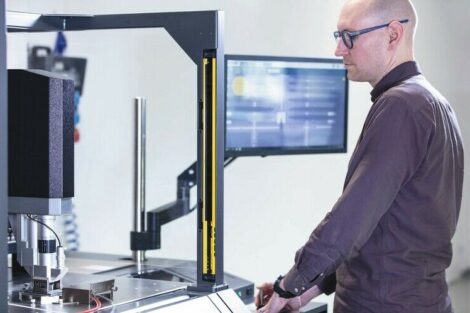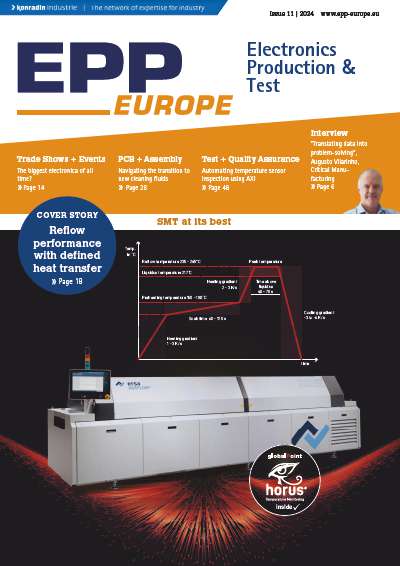Proper packaging of wafers for transport to a semiconductor factory is a critical process. It is necessary to ensure that not even the slightest contamination occurs with the sensitive carriers. The transport containers are sealed and made airtight with special films, often ‘bag in bag’ using both an inner and outer bag: a packaging process which is still done manually by many manufacturers. Front Opening Shipping Boxes (or FOSBs) for shipping up to 25 wafers with a diameter of 300mm are bulky and weigh up to ten kilograms – a not insignificant burden for employees. In addition, when packaging is done manually, a leak test that is 100 percent reliable is not usually possible.
„Based on a single solution for a customer, cts has now developed a standardized modular overall solution that fully automates the entire process of FOSB packaging on request,“ explains Stefan Schmiedlechner, Head of Factory Automation at cts. „Wafer producers thus achieve comprehensive process reliability in three expansion stages, relieve the burden on their employees, free them up for more important value-adding activities and eliminate potential sources of error. With a possible utilization of up to 10,000 FOSB per quarter, which corresponds to 250,000 wafers, the solution is suitable for both medium-sized megafabs and smaller gigafabs with up to six digit production volumes per month. The semi-automatic ‘Manual Bagging’ model and the fully-automatic ‘Auto Bagging’ version are among the most compact solutions on the market and take up as little valuable cleanroom space as possible.“
Packing and leak test
The core of the cts solution is the packaging machine for the FOSB and the vacuum test chamber to ensure correct sealing of the packaging bags. The packaging machine offers four drawers for packaging bags, so transparent or opaque bags can be used for bag-in-bag packaging without changeover. For the packaging process, the machine takes a shipping bag from the appropriate magazine, clamps it open, and a gripper arm lifts the FOSB into the opened bag. The opening is then folded and sealed, while test gas, a mixture of helium and nitrogen, is also fed into the bag to a configurable level. The airtight seal of the package is then verified in the vacuum test chamber afterwards and can thus be documented for each packaged FOSB. With appropriate setup measures, the packaging machine can also be used for smaller carrier systems.
Stage 1 – Automatic packing into transport bags
In the first stage of the fully automatic cts solution, the placement of the FOSB in the insertion rail of the machine is still done by the operator, then the system takes over. After the sealing is completed, the manual transfer to the test chamber takes place, which again performs its work automatically. If bag-in-bag packaging is desired or required, a second round takes place, starting with the manual transfer from the test chamber back to the insertion rail of the packaging machine by the operator. Pre-checking for correct seating of the wafers in the FOSB and their securing mechanisms, as well as labelling of the finished packaged units, is still done manually at this stage. ‘Manual bagging’ requires the least amount of space. The packaging machine occupies only 1.8 by 3.8 metres, and the inspection chamber gets by with a footprint of around one square metre.
Stage 2 – Automation of feeding, optical controls and labelling
Stage 2 automates the process of ready-to-ship packaging to the greatest possible extent – and is realised using vision, label and industrial robot technology. Both the packaging machine, the inspection chamber, two robots and other components are integrated into a complete cell measuring 5.5 by 4.5 meters, which has an input conveyor for the unpackaged FOSB and an output conveyor for the packaged FOSB.
As is common in the semiconductor industry, the supplied FOSB are identified via RFID and the required parameters are queried by the host system via SECS/GEM interface. Based on the information received, the FOSB is checked for correct placement and number of wafers, and all attachments to the box are inspected. A high-tech vision system from the renowned manufacturer senswork is used for this purpose. The entire handling of the FOSB, including feeding to the packaging machine, attachment of desiccant bags (TMB) and transfer to the test chamber, is carried out fully automatically by the industrial robots. They also guide the FOSB to labelling, which is also fully automatic – including subsequent cross-checking of the label for correct printing using camera technology. The packaging material and the number of bag layers are communicated via the host system and thus determine the process flow. The packed FOSB are then made available for further transport by means of an output conveyor. A second output can also be integrated here for the automatic sorting out of defective units.
Stage 3 – Automated transport by autonomous intelligent robots
In the third and highest stage, the transfer of the FOSB to the input conveyor and the pick-up at the output gates are then also fully automated. AMR (Autonomous Mobile Robots) from the cts smart logistics portfolio, adapted to cleanroom requirements, can make a fully autonomous, automated transport process possible in existing environments without costly conversion work. Transport robot systems from cts can be seamlessly integrated into existing fleets for this purpose. However, with the company‘s decades of experience, completely new customized concepts can also be created – including fleet control in all desired areas and comprehensive connection to company systems such as MES or ERP.
Automation creates process
reliability and increases efficiency
The pressure on performance, time and costs in electronics manufacturing is constantly increasing. Smart automation solutions can achieve several goals at once: processes become much easier to control, error rates drop significantly, output increases and employees are freed from strenuous and time-consuming tasks. This is especially true for the safe transport of wafers – damage due to errors in the packaging can quickly cause very high costs in the five-digit range, which can be prevented with the use of suitable solutions such as the bagging system from cts.
Company contact
cts GmbH
competence for technical solutions
Fuhrmannstr. 10
D-84508 Burgkirchen
Germany
Zusammenfassung Résumé Резюме
Eine reinraumgeeignete, modulare Gesamtlösung realisiert die Erhöhung des Automatisierungsgrad von Verpackungen für den Transport von Wafer-Rohlingen zu einem Halbleiterwerk.
Une solution modulaire globale, adaptée aux salles blanches, permet d‘augmenter le degré d‘automatisation du conditionnement pour le transport des ébauches de « wafers » vers une usine de semi-conducteurs.
Подходящее для чистых помещений модульное комплексное решение позволяет повысить степень автоматизации упаковки для транспортировки заготовок полупроводниковых пластин на завод по производству полупроводников.




